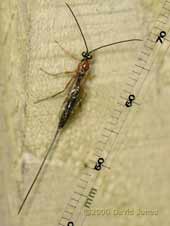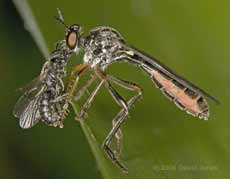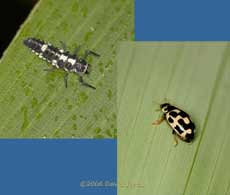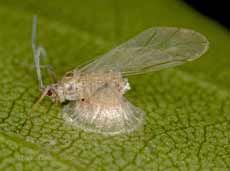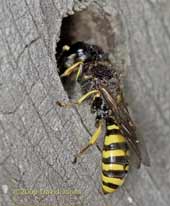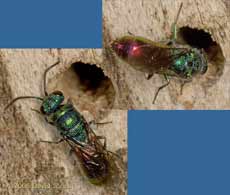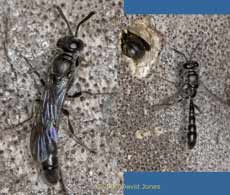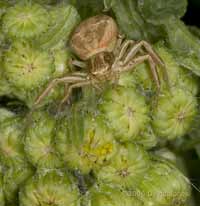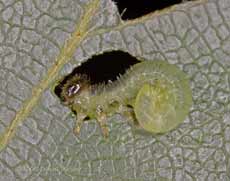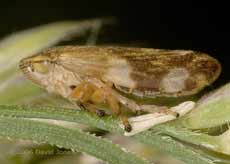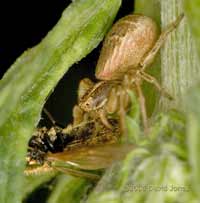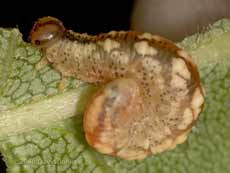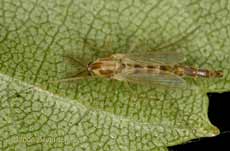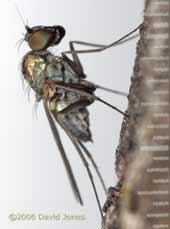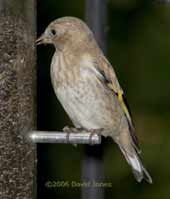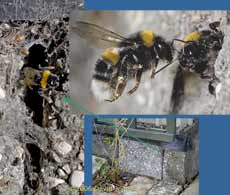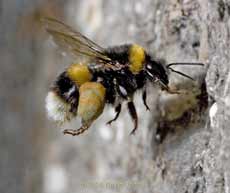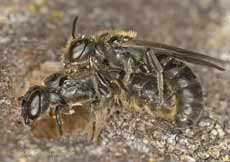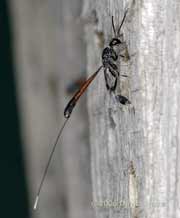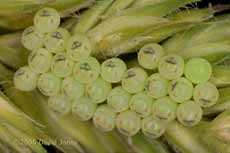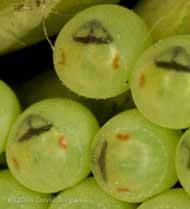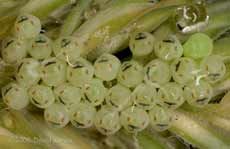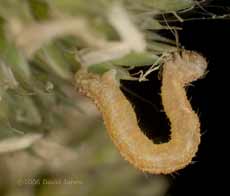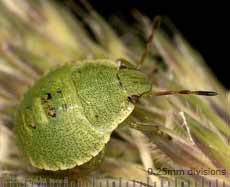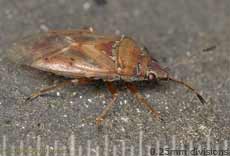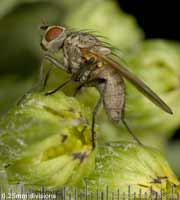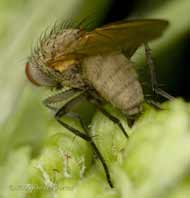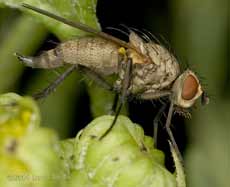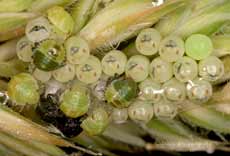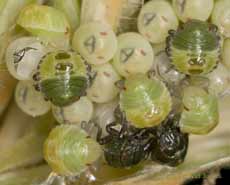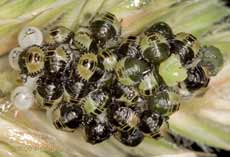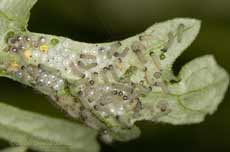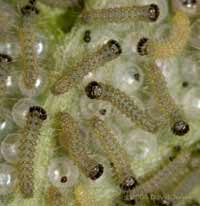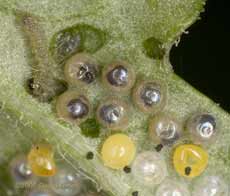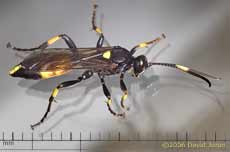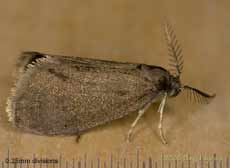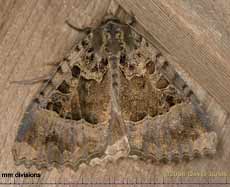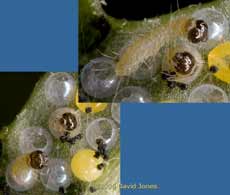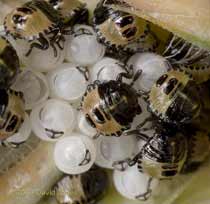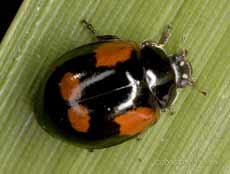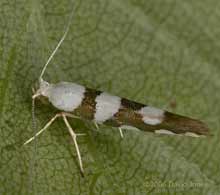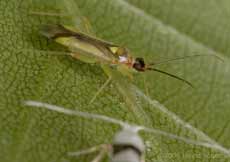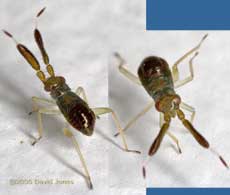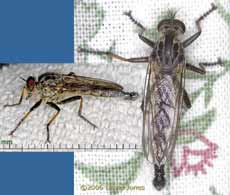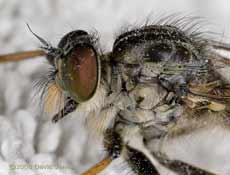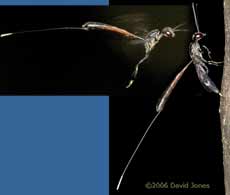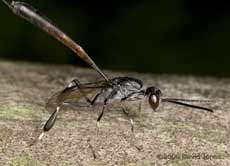Go to the last entry on this page .....Go to previous entry
21 June - The last couple of days have seen lots of time spent with one or other of my sons, so that I haven't spent much time in the garden. The weather has turned cooler, but has remained dry, apart form a little rain last night. It has been quite windy though, causing problems for photography in the garden. Nevertheless, here are some interesting visitors seen yesterday and today -
First of all, an ichneumon fly spotted at the bottom of the garden. I haven't been able to identify it so far, but the white stripes on the head look rather distinctive. It doesn't appear in my guides so I need to spend more time searching on the web.
Today I had the luck to spot this robber fly as it had a meal. It was perched on a bamboo leaf and wasn't disturbed as I held the leaf to steady it in the wind.
On the same bamboo plant I spotted something that is proving elusive this year, a ladybird - in this case a 14-spot Ladybird adult, and also a ladybird nymph of (I think) the same species. Even the Orange Ladybirds are few in number. I only see them occasionally, although I have found a third group of eggs on the Birch tree. The eggs that I photographed on the 16th hatched out yesterday.
I'm not sure what has happened to it, but it looks like some sort of fungus has taken it over?
Activity at the bee hotels has been more intermittent, possibly because of the cooler cloudy conditions. However, the sunny periods bring out the swarm of small bees, and the occasional wasp. I first photographed this one on the 16th, but here are a couple of closer images from this afternoon. So far, the nearest ID match I can find is Ectemnius sexcinctus, although this individual lacks the small yellow markings at the rear of the thorax seen on other images of that species. The hole has a 5mm diameter.
Yesterday, another visitor showed up like a jewel in the sunshine, a ruby-tailed wasp, probably Chrysis ignita. It is a cuckoo wasp, laying its eggs in the nests of other insects. However, yesterday it kept going in and out of an unoccupied hole. It spent the night in there and I don't think it left it all day today - I can see its green face deep in the hole when I shine a torch at it. To give an idea of scale, the hole has a diameter of 4mm.
22 June - A dry day with short sunny periods that didn't really help the solitary bees to get going. I don't think the Ruby-tailed Wasp left its hole all day.
During one of the sunny spells I did manage a few photographs of what I think is a Black Wood Borer Wasp (Trypoxylon figulus). Yesterday it had been going to and from the bee hotel nearest the workshop shed, but reacted too quickly to the movement of the camera.
The Ragworts are getting close to flowering now, and this group of buds is already the ambush site for a 'crab-spider', possibly Xysticus cristatus (or X. erraticus).
Quite a few of the leaves on the lower branches of the Birch tree are now becoming peppered with small holes. Close inspection reveals that the culprits are sawfly larvae.
This froghopper, with its very sleek looking body was on a grass flower head, and is probably the Common Froghopper (Philaenus spumarius).
23 June - A warm day, although early clear blue skies gave way to quite a lot of cloudy periods through the day. I didn't get much in the way of photography (or anything else) today as I've been very tired, but I did take a few pictures.
First of all, a follow-up to yesterday's spider picture. When I looked for it this morning it had caught a hoverfly and was consuming it under the flower heads.
In addition to numerous sawfly larvae similar to the one photographed yesterday, I found two identical caterpillars on adjacent leaves at the end of a branch. I returned later to take more pictures but they had disappeared - bird food?
Exhibiting similar colourings was this gnat under another Birch leaf.
Finally, I didn't see any new 'guests' at the bee hotels today, but the posture of this small fly caught my eye as it rested at the side of one of the hotel blocks. I forgot to include on the image the fact that the scale shows 0.25mm divisions.
24 June - A very warm, sunny day, and I found it very frustrating that I had to rest for too much of the day - damn the CFS. On the bird front the garden has been very quiet over these last few weeks. The House Sparrows are feeding their young, but we rarely see them as they hide amongst the greenery. The Blackbirds are frequent visitors to the area under the Hawthorn, as are a couple of Wood Pigeons and Collared Doves, and today I saw the first Great Tit here since before our holiday
A couple of Goldfinches are regular visitors, but this morning we had this juvenile come to feed, without any adults nearby.
The UK's population of Bumble Bees is in worrying decline because of the spread of intensive agriculture. Here in the garden we always have a Bumble Bees collecting pollen and nectar, and we sometimes have them nesting here.
One side of the shed is supported on concrete building blocks (behind which is our unoccupied hedgehog house, once used by bumble bees). This time the bees have the entrance to their nest in the gap between two block at the corner of the shed (lower, and left image).
I think the bees are Buff-tailed bumblebees (Bombus terrestris), a very common species. If you look at the pollen bundle on the rear leg of this bee, you can see stripes where the bee has collected pollen from different flowers.
The higher temperatures today brought out the Ruby-tailed Wasp. There was another appearance by the solitary wasp, Sapyga quinquepunctatum (a female). Last year I watched a G. jaculator inject its eggs into a bee burrow, and and once the burrow was sealed I marked it. This morning the seal was broken but I missed seeing what emerged. However there was at least one G. jaculator about during the day, although I wasn't able to get any photographs, even though one of them spent time inspecting both me and my camera.
I did manage this picture of a mating pair of the small solitary bees (probably Heriades truncorum).
In case anyone wonders, I have still to sort out my holiday pictures. I need to get them done soon before I completely forget what we did!!
26 June - The sunshine of the last report gave way to largely grey skies yesterday and then rain for most of today, and cool enough to force us back indoors for our meals. It has meant that the water butts have been refilled after I had used some of the water over the last week or so. The weather forecaster has just said that we should have dry and bright weather for the rest of the week. I've finally decided to replace my old tripod with a sturdier model that should be more stable when used with my telephoto lenses.
Yesterday it was quite warm, and the brighter spells brought some activity to the bee hotels, including a visit by this G. jaculator. It didn't seem to be too interested in egg laying.
Back on the 16th I photographed some eggs on the flowerhead of grass by the big pond. At that time they only appeared as green spheres, but yesterday markings were visible on all but one of the eggs - I guess that one may not be fertile. Back in mid-June last year I found a similar group of eggs on a Birch leaf. In that case it was shieldbug nymphs that emerged.
The black markings indicate a hinge where the egg will open once the larvae inside are ready to hatch, and the circle of dots mark the edge of the 'hatch' that opens - in this close-up you can see that the dots are in fact small growths that protrude above the surface.
Despite the rain I decided to check the eggs today, and I thought I'd include this picture of the wet eggs, with the water emphasising their 'smiling face' designs!
On another of the grass flower heads (yesterday) was this small looper caterpillar. While I can't identify the species, looper caterpillars are characteristic of the large, Geometridae family of moths.
There have been two Goldfinch fledglings here today, along with a quartet of adults, and I have seen a Great Tit adult here several times, but without any juveniles visible.
27 June - A dry day with promised to be brighter (enough sunshine in the morning to bring out the Ruby-tailed Wasp) but which turned cloudy, and decidedly dull as the afternoon progressed.
The eggs on the grass are still intact this evening. Sometimes there are numerous bugs on the grass flower heads but this year they are remaining rather quiet. Today, the only insect obvious on any of the flower heads was this shieldbug nymph.
While I was watching the Ruby-tailed Wasp, this adult bug arrived on the top of the water butt. The hardened portions of the front wings look as though they have been secured with rows of rivets!
The first flowers of the Ragwort are now starting to open, and the flower heads have their usual visitors, flies that lay eggs in the buds. These arrive at this time each year, and their larvae badly damage the flowers.
Needless to say, once I pointed my camera their way, I couldn't get a good shot as they were actually egg laying. This was the nearest I could get.
This final image shows the fly afterwards, with its abdomen still extended.
Today's macro images were all taken with an enlarger lens mounted at the end of a group of extension tubes. The combination of this with the ringflash has been very successful, but today I decided to raid the piggybank - I've ordered the Canon specialist lens, the MP-E 65mm lens which will let me take images at magnifications from x1 to x5 without some of the short-comings of my enlarger lens set-up.
28 June - Back to sunny weather today - very pleasant, although I took advantage of a cloudy period to give part of the Hawthorn a trim before all the new growth gets too well developed.
The eggs on the grass started to hatch this morning, revealing their contents to be shieldbugs, as I suspected.
As the exoskeletons of the nymphs harden this close-up shows several at different stages, with a newly emerged individual in the top-left corner and a couple of the first to emerge looking very dark at the bottom of the picture. Notice how the red spots seen in the eggs are in fact the eyes of the nymphs.
By the end of the afternoon nearly all had turned darker, with the exception of a late arrival near to the right of the image.
Not only did the bugs hatch out, but so did the Cinnabar Moth caterpillars - the eggs were laid on the 16th.
As these grow the caterpillars will turn yellow with bold black bands all along their bodies, although there is little sign of that yet.
By the end of the afternoon there were only a few eggs left unhatched. I shall have to check on these tomorrow morning.
During the course of the day we had a visitor in the house in the form of this Ichneumon fly, probably Ichneumon suspiciosus. This is a parasite of caterpillars of various noctuid moths. The multiple reflections are caused by the double glazing window.
I haven't photographed many moths over the last couple of weeks, but here are two from this morning. First of all a small moth which I suspect may be a Bagworm moth (Psyche casta). It measures about 7mm in length.
At the other extreme was this Old Lady Moth (Mormo maura) which is nearly 35mm long.
29 June - Another warm, mainly sunny day. My new lens arrived this morning, and some of today's pictures were taken with it. I'm very pleased with my first 'roll of digital film' taken with it!
By the time I got out into the garden this morning the last Cinnabar Moth caterpillars were hatching out, and I got there just in time to see one of them emerge.
In the meantime the shieldbug nymphs are still gathered around their empty egg cases and have lost their red eyes and green colouring.
Today I couldn't see any Orange Ladybirds, or any of their larvae when I checked the Birch today, and I only saw this one ladybird in the rest of the garden - a colour variant of the 2-spot Ladybird.
While checking the Birch leaves I came across this micro-moth, which I haven't identified yet,
and several of these bugs. The red marks on the antennae and the side of the thorax resembles the red stripe seen on the bug nymphs I photographed back on the 16th - could they be the same species?
Another bug nymph gave me an early chance to play with my new lens. I can't add a scale to these shots, but it was less than 5mm long. Its unusual antennae suggest that it may be Heterotoma merioptera, a bug that inhabits dense vegetation.
This afternoon we had a visitor in the bathroom in the form of this large Robber-fly.
Like other Robber-flies, this one has a 'beard' that help protect its eyes when they catch their prey.
Today, for the first time there were two examples of G. jaculator. Although I didn't get a photograph of it, one of them entered a burrow for the first time. I shall have to watch out for them again tomorrow.
This is a close-up of one of them, taken with the new lens set to 1:1.
30 June - Very warm (a high of 28C), sunny, with the prospect of it getting even hotter over the next few days. No pictures today, but a few things to note as we reach the end of the month. This morning, while Sheila and I were having breakfast outside at around 8.20am a young Song Thrush appeared under the Hawthorn and spent several minutes feeding before disappearing. This is great news, and means that a pair must have nested nearby this year. The Blackbirds are also busy. Both parents are collecting food and I get the impression that their nest is in the line of conifers, almost directly below the tree that the male has always used as its singing stage. Having said that, over the last couple of weeks there has been a change in behaviour by the male. He rarely sings from that tree, instead choosing either the tv antenna on our chimney, or that of a neighbour, or even the gate to our garden! Absent from the garden have been the Robins. In fact, I don't think I have seen or heard one here since we returned from Cornwall - I wonder what has happened to them. What I did hear this morning was the unmistakeable croak of a toad, deep in the undergrowth so there was no hope of seeing it.
Click on the images to see larger versions - |
|
